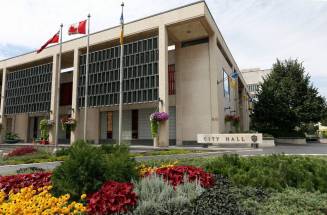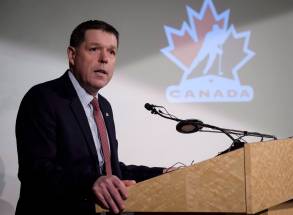Concrete commitments leave deep potholes in civic services Winnipeg’s improved roads can’t continue to be a one-way street for property-tax spending
Read this article for free:
or
Already have an account? Log in here »
To continue reading, please subscribe:
Monthly Digital Subscription
$0 for the first 4 weeks*
- Enjoy unlimited reading on winnipegfreepress.com
- Read the E-Edition, our digital replica newspaper
- Access News Break, our award-winning app
- Play interactive puzzles
*No charge for 4 weeks then price increases to the regular rate of $19.00 plus GST every four weeks. Offer available to new and qualified returning subscribers only. Cancel any time.
Monthly Digital Subscription
$4.75/week*
- Enjoy unlimited reading on winnipegfreepress.com
- Read the E-Edition, our digital replica newspaper
- Access News Break, our award-winning app
- Play interactive puzzles
*Billed as $19 plus GST every four weeks. Cancel any time.
To continue reading, please subscribe:
Add Free Press access to your Brandon Sun subscription for only an additional
$1 for the first 4 weeks*
*Your next subscription payment will increase by $1.00 and you will be charged $16.99 plus GST for four weeks. After four weeks, your payment will increase to $23.99 plus GST every four weeks.
Read unlimited articles for free today:
or
Already have an account? Log in here »
Hey there, time traveller!
This article was published 12/10/2022 (1151 days ago), so information in it may no longer be current.
When it comes to roads, how much is “enough?”
Civic election campaigns represent the best opportunity to debate investments in infrastructure, particularly roads. Most of this year’s mayoral candidates, for example, want to increase spending to fix Winnipeg’s streets, or widen high-volume routes.
“More” is the rallying cry of these candidates.
Candidates do this because it works. Voters — or a huge swath of the electorate, at the very least — think that fixing and expanding roads is the No. 1 job of a municipal government. So, those seeking elected office lavish them with images of smooth, pothole-free roads in every corner of the city.
Voters think that fixing and expanding roads is the No. 1 job of a municipal government.
But the campaign to spend “more” deliberately ignores the question of how much is “enough?” As in, how much money is enough to ensure that Winnipeg roads are slowly getting better?
Here’s a secret that few candidates are willing to admit: we’re already spending enough. In fact, there might even be an argument that we’re spending too much.
A recent feature story in the Free Press confirmed that between 2013 and 2020, there were dramatic improvements in the state of Winnipeg roads: More than 72 per cent of regional streets (such as Portage Avenue and Pembina Highway) are rated “new/good,” up from 60 per cent in 2013; 69 per cent of local roads are rated similarly, up from 58.6 per cent.
Even in a city that is among the worst places on the planet to build and maintain roads (thanks to dramatic temperature fluctuations and a high water table), having 70 per cent of your road inventory rated new or good is quite an accomplishment. No matter how you cut it, city council has made a dramatic improvement in the overall state of our roadways.
MIKAELA MACKENZIE / FREE PRESS FILES The resources dedicated to roads have so dominated civic budgets it is threatening the viability of other services and amenities.
At some point, however, you would think the city would begin to slow the overall increase in roads investment, to allow for investments in other services and amenities that people value. You might think that, but you would be wrong.
The resources city council is dedicating to roads has so dominated civic budgets, it is threatening the viability of other civic services and amenities. Particularly when the 2.33 per cent annual property tax increases that have been in place since outgoing mayor Brian Bowman came to office in 2014 are almost entirely spent on roads and (to a much lesser extent) rapid transit.
Bowman’s dedicated tax hike for roads allowed the city, over the last decade, to double its spending. Over the next six years, the city already plans to spend $145 million a year on roads and depending on who is elected mayor, that figure could go up significantly. Remember that most mayoral candidates support the widening of Kenaston Boulevard and extension of Chief Peguis Trail which, together, will cost about $1 billion. That’s close to the cost of two more rapid-transit lines.
DANIEL CRUMP / FREE PRESS FILES
While most of that money is borrowed, the burden on the operating budget has increased significantly, as well.
According to figures provided by the Canadian Centre for Policy Alternatives, per-capita, inflation-adjusted operating expenditures for road construction and maintenance have increased 27.9 per cent between 2008 and 2020. The only other area of civic government to see that kind of growth was the Winnipeg Police Service, whose budget increased 21 per cent over the same period.
While all that was happening, the CCPA found expenditures on recreation were cut by 31.9 per cent, libraries were cut by by 21.7 per cent and parks and urban forestry cut by 12.7 per cent.
“There are many other examples that could be highlighted, but dedicating all property tax increases to infrastructure and police seems to be creating a zero-sum situation for other service areas,” said CCPA spokesman Niall Haney. “Community services, parks, city beautification are losing out.”
“Community services, parks, city beautification are losing out.”–NiallHaney
The original decision to shackle the majority of property tax increases to roads was not wrong, at the time. Property taxes had been frozen for many years under mayors Glen Murray and Sam Katz. Those freezes allowed Winnipeg property values to rise significantly without punitive tax increases. But they also left the city’s roads and related infrastructure in a state of crisis.
Now, thanks to the efforts of past councils and mayors, we’ve actually, remarkably, turned the corner on roads.
We will never reach a state where 100 per cent of the roads qualify as new or good. Hotter temperatures in the summer, colder temperatures in the winter and volatile seasonal precipitation — the inescapable byproducts of climate change — will ensure that there will always be roads in desperate need of repair or replacement.
Perhaps it’s time to ask whether we really need to continue a policy of perpetual increases in the roads budget.
But at current funding levels, it appears there will be fewer of those roads every year. In that context, perhaps it’s time to ask whether we really need to continue a policy of perpetual increases in the roads budget.
The city will need some help in its bid to balance investments in infrastructure with other civic priorities. It will need a provincial government that is willing to end its cynical freeze on operating grants to municipalities. And ongoing, consistent help from Ottawa and the province on covering the escalating costs of infrastructure, particularly mega-projects.
However, the move to a more balanced approach has to start at city hall. Otherwise, we’re at risk of becoming over-policed city with pristine roads and not much else.
dan.lett@winnipegfreepress.com

Born and raised in and around Toronto, Dan Lett came to Winnipeg in 1986, less than a year out of journalism school with a lifelong dream to be a newspaper reporter.
Our newsroom depends on a growing audience of readers to power our journalism. If you are not a paid reader, please consider becoming a subscriber.
Our newsroom depends on its audience of readers to power our journalism. Thank you for your support.





